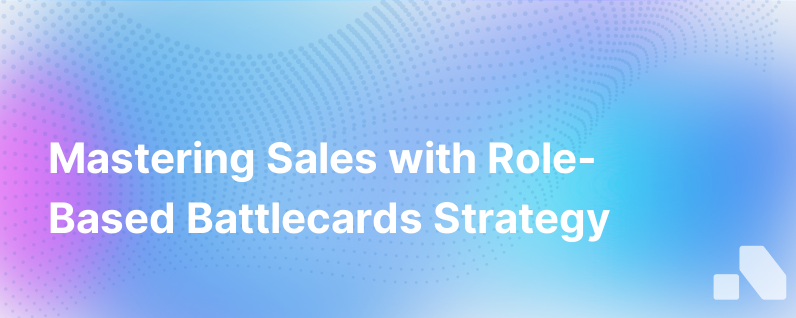
Effective sales call preparation is crucial for any B2B sales team. This is where role-based battlecards come into play. They provide a tailored, strategic guide to handling calls with different stakeholders, ensuring your sales reps are prepped and ready for any conversation.
In this comprehensive guide, we'll delve deep into the concept of role-based battlecards. We'll cover what they are, why they're key to a successful sales strategy, and how to create your own.
Understanding Role-based Battlecards
A role-based battlecard is a sales tool that provides custom information and strategies for dealing with specific roles within a prospect's organization: CEO, CTO, CFO, COO, middle management and end-users, to name a few.
While traditional battlecards focus on broader aspects like product features or competitors, role-based battlecards zoom in on the unique pain points, expectations, and criteria critical to each role. This allows sales reps to tailor their conversation to their audience, establishing trust and confidence.
The Importance of Role-based Battlecards
Role-based battlecards can greatly increase the effectiveness of your sales team in several ways:
- Increased Relevance - By understanding the unique concerns and goals of each role, your sales team can craft their message to resonate on a personal level with each stakeholder.
- Improved Communication - Different roles speak different languages. Role-based battlecards equip sales reps with terminology, context, and talking points that demonstrate thorough understanding and credibility.
- Accelerated Sales Process - Thanks to role-specific insights, your sales reps can address decision-makers' concerns more effectively and quickly, reducing time-to-close.
- Eased Objection handling - Objections can vary significantly by role. Role-based battlecards help reps anticipate, prepare for, and confidently navigate objections, increasing win rates.
In the broader B2B sales context, role-based battlecards can transform the sales approach from generic to strategic, laying the groundwork for meaningful conversations and stronger client relationships.
How To Create Role-Based Battlecards
To create effective role-based battlecards, follow these five steps:
-
Identify Key Roles in Buying Process: The first step is to identify the roles involved in the prospect's decision-making process. These typically include exec-level roles like CEO or CTO, strategic roles like IT managers or Procurement, and end-users. Don't forget to consider any influencers within the organization.
-
Understand Each Role's Pain Points and Goals: Every role in the organization has distinct responsibilities, concerns, and success metrics. A CFO may worry about budget and ROI, an IT Manager might prioritize security or saving time, and end-users may focus on ease of use. Understand these factors for each role to tailor your approach.
-
Craft Tailored Messaging and Value Proposition: Based on the pain points and goals you've identified, create a value proposition and messaging tailored to each role. Showcase how your solution addresses their unique concerns and helps them achieve their objectives.
-
Prepare For Objections: Each role may have distinct objections based on their concerns and priorities. Anticipate these objections and equip your team with clear, articulate responses to confidently handle these moments.
-
Collect Success Stories and Proof Points: Gather role-specific stories, testimonials, and data points that demonstrate your product's impact, and include them in your battlecard. These real-world examples can significantly boost your credibility and persuasiveness.
Leveraging Role-based Battlecards Efficiently
Role-based battlecards are most effective when they're updated regularly, easy to access, and intuitive. Organize your battlecards in your CRM or a dedicated sales enablement platform. Regularly update battlecards with new insights, objections, and success stories to keep them relevant and powerful.
Remember, role-based battlecards should be easily digestible. The last thing you want in a sales conversation is your rep paging through tons of data to find the relevant information. Make sure these crucial details are easy to find and clearly presented.
The Future of Role-based Battlecards
With AI technology like Aomni, the laborious process of creating and maintaining role-based battlecards is being revolutionized. Aomni's AI platform provides real-time account research, actionable competitive insights and personalized sales content. It captures all the insight you need about each role, presents it in an accessible format, and keeps it up-to-date. This has a transformative impact on your sales process, driving higher win rates and faster revenue growth.
Conclusion
Role-based battlecards are a strategic tool that has the potential to significantly increase the effectiveness of your sales team by enabling tailored, impactful conversations with key decision-makers. The combination of understanding the unique needs of each role, being prepared for their possible objections, and having at hand compelling success stories is sure to boost your win rate. At Aomni, we believe in the power of role-based battlecards, and we've made it even easier and more effective with our robust AI technology.